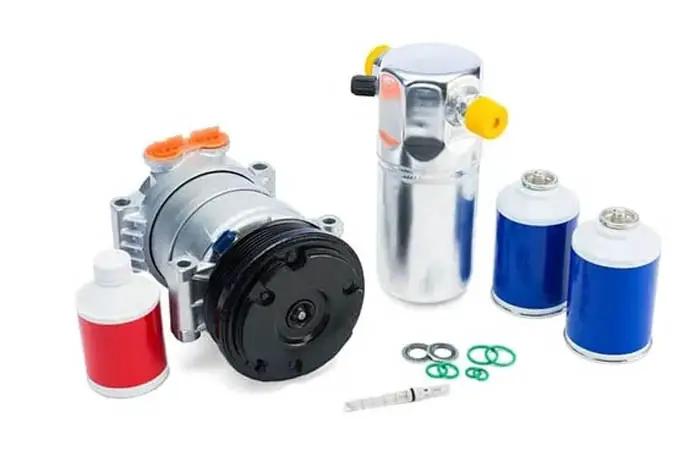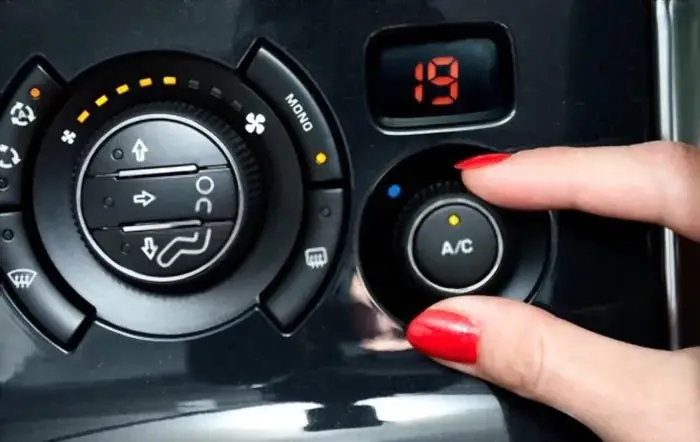
The air conditioning system in your car is responsible for providing cold air and maintaining a comfortable temperature inside the vehicle. Car A/C refrigerating gas is the blood of the A/C system and is used to remove the warm air in vehicles. It flows in the whole air conditioner system to make your car cold. Different types of refrigerants are used in the car A/C system, which is commonly known as HVAC. It is important to know the three refrigerant types to become a professional.
In this powerful article, you will quickly learn the auto air conditioner refrigerants and three different types of A/C refrigerating gas for cars such as R-12, R-134a, and R-134yf refrigerants.
Related Post: Car A/C Smells Bad When First Turned ON
What Is Vehicle Air Conditioner Refrigerant
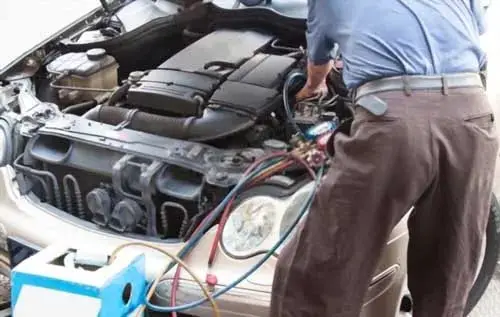
Refrigerant is a volatile gas used in the refrigeration cycle of an A/C system. Car’s air conditioning system converts the refrigerating gas phases from liquid to gas and back again in A/C systems.
Firstly, the A/C refrigerating gas is compressed by the compressor and becomes liquid, then it is cooled off in the condenser. The cooled A/C refrigerating gas is then auto allowed to expand in the evaporator, where the evaporator works to convert liquid into a gas and absorbs heat in the surrounding area of the car or truck interior. A coil of tubes acts as an evaporator in car refrigeration to cold the air.
In the end, again the refrigerating gas is sent back to the compressor, where it becomes liquid. Car refrigerating gas is volatile, flammable, and toxic, and contributes to ozone depletion, which causes global warming. That is why it is illegal and prohibited in air conditioning units to vent car A/C refrigerating gas into the atmosphere.
Related Post: How Car Air Conditioner Works
Car AC Refrigerant Types
A/C system became a crucial component of the car and it is important to know what kind of refrigerant is being used in your Car’s A/C system. The A/C uses different refrigerating gases for cooling purposes. These refrigerating gas are not general gases they are laboratory-made gases and have very high cooling properties when expanded.
The Environmental Protection Agency (EPA) regulates the use of refrigerants in A/C systems to reduce their impact on the environment. These gases can be refilled in every car when you need them, mostly when you see a leaking refrigerating gas in air conditioning units.
Car A/C refrigerating gases are of many types used in A/C systems. Here we will mention the three most commonly used refrigerating gases are R-12 refrigerating gas (Freon, Freon-12, R-12, CFC-12) in automobile A/C systems. These gases are Produced in accordance with global warming, create optimistic gestures and do better for the environment.
- R-12 Refrigerant (Freon, Freon-12, R-12, CFC-12)
- R-134a Refrigerant (HFC-134a)
- R-1234yf Refrigerant (HFO-1234yf)
Related Post: How To Fix Car AC Compressor
1. R-12 Refrigerant (Freon, Freon-12, R-12, CFC-12)
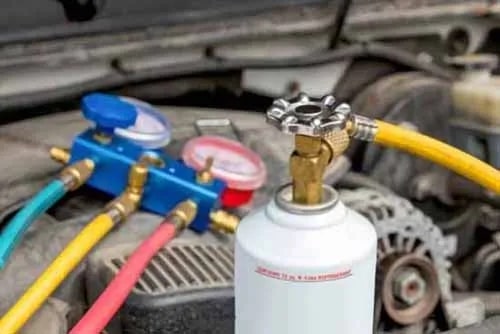
R-12 refrigerant also known as Freon, Freon-12, R-12, and CFC-12 is a kind of freon A/C refrigerating gas. Its chemical name is dichlorodifluoromethane. R-12 has the molecules of chlorine, fluorine, and carbon; it is also called chlorofluorocarbon (CFC).
R-12 is a laboratory-man-made refrigerant; it was widely used in automobile AC systems. It is best for cars manufactured before 1995, R-12 refrigerating gas was the standard for automotive air conditioning. It is a colorless, odorless, non-explosive, and non-flammable gas. It was perfectly doing its job until scientists discovered that it is responsible for the rapid deplete the ozone layer.
This was the reason scientists were compelled to find out the solution to rapidly increasing global warming. Its climate impact is 2400, which is very high compared to carbon dioxide (CO₂), which has a climate impact of one according to 2021 federal and standard protocol. R-12 is still in use in antique and old vehicle types, but such older vehicles are very rare in number now.
Luckily they found an ozone-friendly refrigerating gas R134a, which contributes less to global warming as compared to r-12 refrigeration gas. So, from 1994, r-12 refrigerating gas was banned in new cars, and R134a refrigerant started to use in car A/C systems. An environmentally friendly refrigeration system utilizes refrigeration gas with low climate impact and minimizes the release of refrigerating gas into the atmosphere, helping to reduce its impact on the environment.
Related Post: How To Recharge Car Air Conditioner
2. R-134a Refrigerant (HFC-134a)
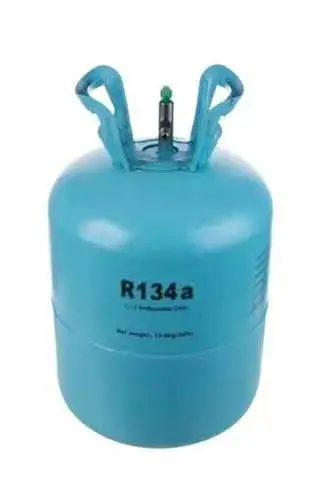
R-134a is a type of A/C refrigerating gas used in the A/C system. It is the replacement for R-12. HFC134a is a hydro-fluorocarbon (HFC). Its chemical name is tetrafluoromethane. Back at the end of the 20th century, engineers found that R-12 is an eco-enemy refrigerant; as a result, a new refrigerating gas was developed in the lab called R134a. However, some vehicles still use R-12 as a refrigerating gas for their A/C systems on the road today.
R134a is an odorless, colorless, non-flammable, and non-corrosive gas. It has the capability to remove more heat from the vehicle than R-12. This means with the same type of vehicle and the same amount of refrigerating gas, the vehicle containing R134a refrigerating gas has the capability to remove more heat as well as humidity from the vehicle than the R-12. It became the best option for car manufacturers due to its insignificant ozone depletion potential. It is still legal to drive the vehicle on systems that use freon when the vehicle was manufactured before 1995.
In 1995, R134a became the new standard for refrigerating gas in the automotive industry. At the time, engineers believed that it had a positive environmental impact. However, later discoveries revealed that it had the potential for contributing to greenhouse gas emissions and a long-term effect on global warming.
It has a slightly lower climate effect of 1430 as compared to R-12. A new refrigerating gas R-134yf is discovered, which has a climate impact of less than R134a refrigerating gas. R134a is found to cause cancer, birth defects, and reproductive harm.
3. R-1234yf Refrigerant (HFO-1234yf)
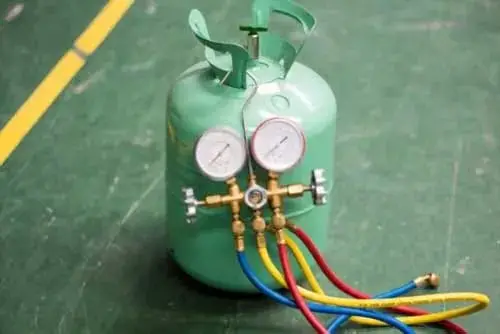
R1234yf also known as HFO-1234yf, is a type of A/C refrigerating gas. Its chemical name is tetrafluoropropene. R 123yf has been used as a replacement for R134a refrigeration gas since 2011, which Renewed R-12 refrigerating gas and many vehicle manufacturers have switched to using r1234yf in their A/C systems.
It is a colorless and slightly flammable refrigerating gas. R-134yf has a global warming potential (GWP) of less than 1 as compared to CO2, which has a climate impact of 1. It means that 100 grams of r1234yf released into the atmosphere has a lower greenhouse effect than 100 grams of CO2 released into the atmosphere.
R1234yf has similar thermal properties to R134a. There are only a few systems and design differences. Both refrigeration gases have the same procedure and method to troubleshoot a problem. By 2021 all new cars will replace R-134a refrigerating gas. Some vehicles have already switched to R-134yf.
Related Post: Types Of Compressor Oil: Mineral, PAO, POE, PAG Oil, & Purposes
What Causes Freon Gas Leaks In Car Air Conditioners
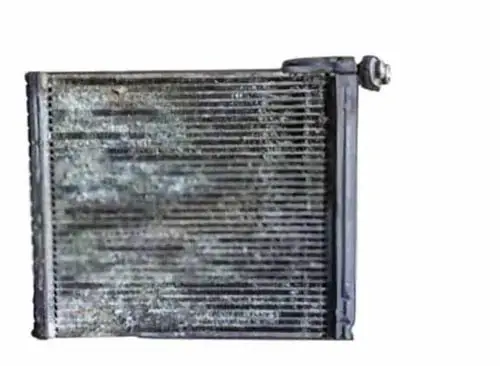
A car A/C flow is a very common issue almost every car owner faces. A normally operated A/C system should maintain and circulate the same amount of refrigeration gas throughout its entire life.
So, a decrease in the amount of refrigeration gas is a sign of leakage. Automobiles having an A/C system, leak refrigeration gas via seals, hoses, crimp connections, or tiny breaks in the hose pipes.
The leakage occurs with old-age cars mostly, even, in new cars too leakage occurs. But the older the car, the higher the rate of leakage. And here is one interesting part you need to know.
“According to air conditioning expert of the society of auto engineers (SAE) Ward Atkinson says, the A/C system is not fully airtight, It is nearly airtight. Refrigerants always trying to escape from the system”.
Here is the real reason you need to know why refrigeration gas escapes from the A/C system.
Look, In winter, A/C seals can easily become defective than in summer because of A/C system isn’t used as much. Due to less usage of the A/C system, seals and hoses can dry out making refrigeration gas flow.
That is why refrigeration system experts say, you should run your A/C for at least 10 minutes in a month even during winter for seals and hoses elasticity. Furthermore, I want to clarify that every year up to 10% of the refrigeration gas escapes from the full airtight A/C system due to natural evaporation. It happens through microscopic pores in hoses, seals, and crimped connections.
And also for your kind information, the R-134a system doesn’t flow as much as the R-12. An A/C system that contains less than 2% of air by weight is considered normal. Whereas an increase in the amount of air in the system decreases the cooling capacity correspondingly.
So, more than 6% of the air in the system can harm the cooling capacity. So, guys I know that is a lot to take in, but stick with me, here is another factor you need to know for refrigeration gas flow.
One of the main reasons for refrigeration gas leaks is Moisture. It is the kiss of death for the automobile A/C system.
Moisture mixed with refrigeration gas produces corrosive acid. This corrosive acid formation can lead to eating away seals, sludging, and even freezing the whole A/C system.
Places Where Car AC Leak Can Occur
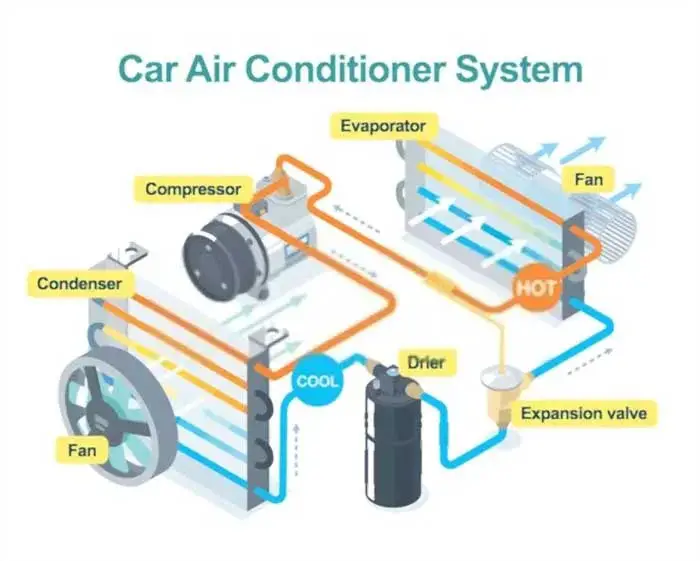
- One of the common places of a refrigeration gas flow is the condenser. Road debris, dust, and leaves accumulate on the outside surface of the condenser and create holes.
- “O” ring seals are more prone to physical damage especially in high-pressure fittings due to high-pressure refrigeration gas.
- Hose pipes and crimped connections are soft lines and have high chances of leaks, because of vibration as the compressor vibrates often with the engine.
- Compressor “O” ring seal can become dry and leak.
- One of the mysterious leaks that occur is in the evaporator. It is an invisible leak and difficult to find out because it is buried deep and hidden under the dashboard. It is a very expensive flow too.
- A blocked drain port will set the evaporator in a bath of water and creates leakage and also mold, mildew, and corrosion will occur.
What Are the Dangers of Car Air Conditioner Refrigerant Leaks
Driving a car on a hot day can be uncomfortable without a functioning A/C system to provide cold air inside the car. However, if the A/C system begins to leak refrigerant, it can pose various dangers to both the car and the environment. Below are the dangers of car cooling systems refrigerating gas leaks.
- Fire Hazard: Refrigerating gases have flammability effects, and a leak can cause a fire in the engine compartment.
- Health Risks: Refrigerating gases can be toxic if inhaled in large amounts.
- Environmental Damage: Refrigerating gases contribute to ozone depletion and global warming.
- System Failure: A leak can reduce the efficiency of the A/C system, leading to system failure.
- Costly Repairs: Leaks can cause corrosion and other damage to the system, leading to expensive repairs.
- Reduced Fuel Efficiency: A leak in the A/C system can reduce fuel efficiency, making your car consume more gas.
Car AC Leak Detection Methods
Pinpointing an A/C leak is a difficult task because refrigeration gas has no apparent signs, and sometimes oily dust accumulates in the leakage area. Various methods are used to find out the leaks.
1, Visually Inspect
Before applying any method to find out leakage, it is best to visually inspect all the A/C parts such as the compressor, condenser, hose pipes, and crimped joints to verify that they all are airtight. Usually, when refrigeration gas leaks, lubricating oil also flow, as a result, oily dust builds upon the surrounding area.
2. Adding Ultraviolet Fluorescent Dye
One method of tracing refrigeration gas leaks is to add ultraviolet fluorescent dye with refrigeration gas (It is available in a metal Can, and can be mixed with refrigeration gas). Whenever a leakage occurs, you can pinpoint the leak under the ultraviolet lamp, the colored dye glows brightly.
3. Putting Soap Solution
A soup solution is also used to find out the flow. Spray soap solution on suspected areas such as joints and crimped connections and watch for bubbles.
4. Electronic Leak Detector
An electronic leak detector is also used to detect leakage. An electronic flow detector is sensitive to sound, when a leaking sound is registered to the device it converts it to high-pitched noise.
Conclusion
In conclusion, it is important to research the different types of refrigeration gas that are available for your car. Different types of refrigerating gases have different properties that make them suitable for specific purposes or applications. R134a is the most widely used refrigerating gas in automobiles because it is non-toxic and provides excellent cooling performance. R1234yf is a newer alternative with reduced environmental impact.
Frequently Asked Questions (FAQs)
In order to determine whether your A/C is R12 or R-134a, you will need to consult the owner’s manual or contact the manufacturer. R12 is a refrigerating gas that was used in older model A/C units, while R-134a is a newer refrigerating gas that is used in most modern A/C systems.
If you want to know whether your A/C uses R12 or R-134a in the service port of the car, you can either look at the label on the A/C unit itself or under the hood or find the model number and look up the specifications online. If the label on the A/C unit says “R12” then it uses R12 Freon. If the label says “R-134a” then it uses R-134a. You can also tell by looking at the hoses and fittings on the A/C unit.
R12 Freon was the most common type of Freon used in the classic car up until the early 1990s. It is now illegal to produce or sell R12 Freon because it damages the ozone layer. However, there are still a limited number of dealerships that have stock of R12 Freon and can sell it for use in older cars.
A clicking sound in a vehicle’s refrigeration system is often caused by the expansion and contraction of metal components, such as the refrigerating gas lines or the evaporator, due to temperature changes.
Mixing different types of A/C coolants in a vehicle’s A/C system can cause chemical reactions that can result in damage to the system components, such as corrosion, clogging of the condenser and reduced cooling performance. Therefore, it is important to only use the specified type recommended by the car manufacturer to avoid potential problems and ensure optimal performance of the A/C system.
Every car has an A/C system that cools and dehumidifies the air inside the car, providing a comfortable environment for the occupants. The system typically consists of a compressor, a condenser, an evaporator, a refrigerating gas, and various other components that work together to cold the air. Regular maintenance, including regular checks of the refrigerating gas levels and inspections of the system components, is important to ensure that the A/C system continues to operate effectively and efficiently.
Sign Up

